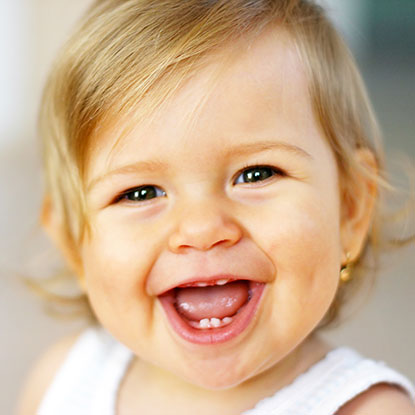Are you prepared for the arrival of your baby’s first tooth? Follow these guidelines and your son or daughter will be on the way to a lifetime of healthy smiles!
Caring for Gums
Even before your baby’s first tooth appears, their gums can benefit from your careful attention. After feeding, wrap one finger with a clean, damp washcloth or gauze and gently rub it across your baby’s gum tissue. This clears your little one’s mouth of any fragments of food and begins the process of building good daily oral care habits.
Baby’s First Tooth
When that first tooth makes an entrance, it’s time to upgrade to a baby toothbrush. There are two options: a long-handled toothbrush that you and your baby can hold at the same time, and a finger-puppet-like brush that fits over the tip of your pointer finger. In each case, the bristles should be soft. At this stage, toothpaste isn’t necessary; just dip the brush in water before brushing.
Brushing with Toothpaste
When a few more teeth appear, you can start using toothpaste on your child’s brush. At this stage, use only a tiny amount of fluoridated toothpaste (the size of a grain of rice). From the beginning, have your little one practice spitting the toothpaste out after brushing.
First Visit to the Dentist
The American Academy of Pediatric Dentistry recommends that children visit the dentist within 6 months of the first tooth coming in, or by their first birthday, whichever comes first. It is important that your child’s newly erupted teeth (typically erupting at 6 to 12 months of age) receive proper dental care and benefit from proper oral hygiene habits right from the start. Your child should visit the dentist every six months for regular dental cleanings and exams. We also recommend fluoride varnish treatment at each cleaning to keep teeth their strongest and to prevent cavities.
Teeth Eruption
Your child’s primary/baby teeth will not all be in until around age three. During teething, your child’s gums may feel tender and sore. To help alleviate this discomfort, we recommend that you soothe the gums by rubbing a clean finger or a cool, wet cloth across them. You may also choose to use a teething ring.
Your child’s primary teeth are shed at various times throughout childhood, but are not typically all gone until around the age of 12! Permanent teeth begin erupting around age 6, and with the exception of wisdom teeth, are typically all in by the age of 12 or 13. Adults have twenty-eight permanent teeth (or up to thirty-two, including wisdom teeth).
Preventing Decay
Do not give your baby any sweetened flavored drinks or soda. Even the sugar in ‘healthy’ drinks like real fruit juice, formula, and milk (this goes for breast milk as well) can cause decay, so regular teeth and gum cleaning is vital. Never put your baby to bed with a bottle; sugary liquids in prolonged contact with teeth are a guarantee for early childhood caries, also known as baby-bottle tooth decay.
Setting a Good Example
Children love to imitate their parents so please model ideal home dental care. Brush twice and floss once daily while your child is watching to show the importance of your good habits. Most children do not have the dexterity to thoroughly clean their own teeth until they’re about six or seven, so you’ll have to help and monitor daily. The primary goal is to instill healthy oral habits at an early age to set your child up for a lifetime of healthy, cavity-free teeth!


